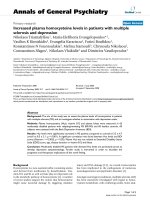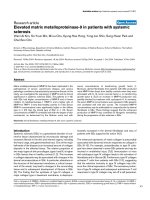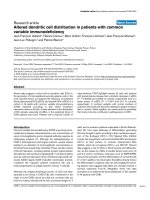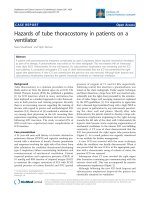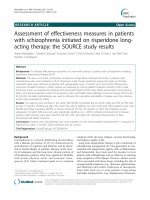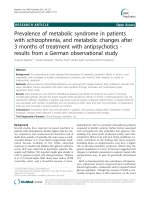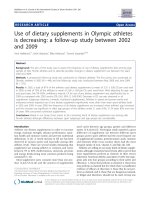Bóa cáo y học: "Failure of non-invasive ventilation in patients with acute lung injury: observational cohort study" ppt
Bạn đang xem bản rút gọn của tài liệu. Xem và tải ngay bản đầy đủ của tài liệu tại đây (160.8 KB, 5 trang )
Open Access
Available online />Page 1 of 5
(page number not for citation purposes)
Vol 10 No 3
Research
Failure of non-invasive ventilation in patients with acute lung
injury: observational cohort study
Sameer Rana
1
, Hussam Jenad
1
, Peter C Gay
1
, Curtis F Buck
2
, Rolf D Hubmayr
1
and
Ognjen Gajic
1
1
Department of Internal Medicine, Division of Pulmonary and Critical Care Medicine, Mayo Clinic, Rochester, Minnesota USA
2
Department of Anesthesiology, Division of Intensive Care and Respiratory Care, Mayo Clinic, Rochester, Minnesota USA
Corresponding author: Ognjen Gajic,
Received: 3 Jan 2006 Revisions requested: 31 Jan 2006 Revisions received: 15 Feb 2006 Accepted: 19 Apr 2006 Published: 12 May 2006
Critical Care 2006, 10:R79 (doi:10.1186/cc4923)
This article is online at: />© 2006 Rana et al.; licensee BioMed Central Ltd.
This is an open access article distributed under the terms of the Creative Commons Attribution License ( />),
which permits unrestricted use, distribution, and reproduction in any medium, provided the original work is properly cited.
Abstract
Introduction The role of non-invasive positive pressure
ventilation (NIPPV) in the treatment of acute lung injury (ALI) is
controversial. We sought to assess the outcome of ALI that was
initially treated with NIPPV and to identify specific risk factors for
NIPPV failure.
Methods In this observational cohort study at the two intensive
care units of a tertiary center, we identified consecutive patients
with ALI who were initially treated with NIPPV. Data on
demographics, APACHE III scores, degree of hypoxemia, ALI
risk factors and NIPPV respiratory parameters were recorded.
Univariate and multivariate regression analyses were performed
to identify risk factors for NIPPV failure.
Results Of 79 consecutive patients who met the inclusion
criteria, 23 were excluded because of a do not resuscitate order
and two did not give research authorization. Of the remaining 54
patients, 38 (70.3%) failed NIPPV, among them all 19 patients
with shock. In a stepwise logistic regression restricted to
patients without shock, metabolic acidosis (odds ratio 1.27,
95% confidence interval (CI) 1.03 to 0.07 per unit of base
deficit) and severe hypoxemia (odds ratio 1.03, 95%CI 1.01 to
1.05 per unit decrease in ratio of arterial partial pressure of O
2
and inspired O
2
concentration – PaO
2
/FiO
2
) predicted NIPPV
failure. In patients who failed NIPPV, the observed mortality was
higher than APACHE predicted mortality (68% versus 39%, p <
0.01).
Conclusion NIPPV should be tried very cautiously or not at all in
patients with ALI who have shock, metabolic acidosis or
profound hypoxemia.
Introduction
Non-invasive positive pressure ventilation (NIPPV) is the
accepted initial mode of treatment in subsets of patients with
acute respiratory failure, the foremost exacerbation of chronic
obstructive pulmonary disease with hypercarbia [1], and also
in immunocompromised hosts [2,3], patients with cardiogenic
pulmonary edema [4,5] and as a weaning aid in chronic
obstructive pulmonary disease [6]. The efficacy of NIPPV in
the initial management of other forms of hypoxemic respiratory
failure, such as acute lung injury (ALI), pneumonia or postextu-
bation respiratory failure, remains controversial [7-9]. Continu-
ous positive airway pressure (CPAP) has been shown to be of
no benefit in non-selected patients with acute hypoxemic res-
piratory failure and was associated with a higher number of
adverse events [10]. While a prospective multicenter study
identified ALI as an independent predictor of failure of NIPPV
[11], specific underlying risk factors, such as presence of
shock or metabolic acidosis, have not been evaluated in this
group of patients. The uncertainty of the benefit of NIPPV in
patients with ALI is reflected in a recent survey of NIPPV prac-
tice in which less than 40% of providers consider NIPPV to be
beneficial in this group of patients [12]. The present study was
undertaken to evaluate the outcome of patients with ALI
treated with NIPPV as the initial mode of therapy and to iden-
tify factors predicting success/failure of NIPPV in this group of
patients.
ALI = acute lung injury; APACHE = Acute Physiology and Chronic Health Assessment; CI = confidence interval; CPAP = continuous positive airway
pressure; DNR/DNI = do not resuscitate/do not intubate; ICU = intensive care unit; NIPPV = non-invasive positive pressure ventilation.
Critical Care Vol 10 No 3 Rana et al.
Page 2 of 5
(page number not for citation purposes)
Materials and methods
The present study was undertaken in two intensive care units
(ICUs) of a tertiary care center. The institutional review board
waved the informed consent requirement. Consecutive criti-
cally ill medical patients who met ALI criteria and who were
treated with NIPPV as the initial mode of therapy between
March and October of 2004 were included. The decision to
intubate was left to the discretion of the treating intensivist. ALI
was defined according to the American-European Consensus
Conference definition [13]. Sepsis and shock were defined
according to the American College of Chest Physicians/Soci-
ety of Critical Care Medicine Consensus Conference defini-
tion [14].
Patients who had 'do not resuscitate/do not intubate' prefer-
ences (DNR/DNI) or refused research authorization were
excluded (Figure 1). The main outcome measure was failure of
NIPPV defined as subsequent intubation and invasive
mechanical ventilation. Secondary outcomes were hospital
mortality and ICU length of stay.
Data on demographics, DNR status, diagnoses, acute physiol-
ogy parameters (vital signs, arterial blood gases, blood urea
nitrogen, creatinine, bilirubin and hematocrit), severity of ill-
ness scores, mortality and length of ICU stay were prospec-
tively collected by the bedside nurse into the Acute Physiology
and Chronic Health Assessment (APACHE) III database. The
characteristics of the ICU and the APACHE database have
been previously described [15].
NIPPV was delivered through a full face mask in all patients.
Patients who received bi-level pressure ventilation were venti-
lated with the 'Vision' NIPPV ventilator (Respironics Inc.,
Carlsbad, CA, USA). Data on inspiratory and expiratory pres-
sure and estimated tidal volume were prospectively collected
four times a day and documented in the respiratory therapy
electronic medical record. The respiratory therapist confirmed
the absence of air leak prior to recording the tidal volume
value. The minority of patients in whom the initial mode of ven-
tilation was CPAP, positive pressure was delivered by either
'Vision' NIPPV ventilator or a custom CPAP delivery system
(Down's Flow Generator, Vital Signs Inc., Totowa, NJ, USA). In
this group of patients the respiratory rate and airway pressure
but not tidal volume were recorded.
Categorical variables were compared using standard Chi
square and Fisher's exact tests as appropriate. Wilcoxon rank
sum test was used to compare continuous variables. To eval-
uate the risk factors for NIPPV failure, a multivariate logistic
regression model was created. Variables that were associated
with NIPPV failure in univariate analysis (p < 0.1) were entered
and a forward selection process identified the final model con-
taining no more than three predictor variables. JMP statistical
Figure 1
Outline of the studyOutline of the study. CPAP, continuous positive airway pressure; DNI, do not intubate; DNR, do not resuscitate; NIPPV, non-invasive positive pres-
sure ventilation. PaO
2
/FiO
2
, ratio of arterial partial pressure of O
2
and inspired O
2
concentration
Available online />Page 3 of 5
(page number not for citation purposes)
software (JMP, Version 5, SAS Institute Inc., Cary, NC, USA)
was used for all data analyses.
Results
A total of 358 patients received NIPPV over the six month
study period. Of these, 79 patients initially started on NIPPV
fulfilled criteria for ALI (Figure 1). After excluding 23 patients
with DNR/DNI orders and two patients who refused research
authorization, 54 patients were included in the analysis. The
principal diagnosis was pneumonia in 34 (63%) patients, fol-
lowed by vasculitis in 8 (15%) patients, nonpulmonary sepsis
in 6 (11%) patients and interstitial lung disease exacerbation
in 6 (11%) patients; 38 (70.3%) patients failed NIPPV. Table
1 describes clinical characteristics of the ALI patients sorted
by outcome of NIPPV. Patients who failed NIPPV were more
likely to have metabolic acidosis, higher severity of illness
scores and a greater degree of hypoxemia (Table 1). None of
the 19 patients with shock succeeded on NIPPV therapy.
Being started on CPAP as opposed to bi-level ventilatory sup-
port as the form of NIPPV did not predict failure of therapy. The
patients who failed NIPPV had higher minute ventilation and
tended to have higher estimated tidal volumes (Table 2).
In a multivariate logistic regression analysis restricted to
patients without shock, forward selection identified three vari-
ables (ratio of arterial partial pressure of O
2
and inspired O
2
concentration – PaO
2
/FiO
2
, base excess and APACHE III
scores) in the final model (r
2
= 0.37). Metabolic acidosis (odds
ratio 1.27, 95% confidence interval (CI) 1.03 to 0.07 per unit
of base deficit) and severe hypoxemia (odds ratio 1.03, 95%CI
1.01 to 1.05 per unit decrease in PaO
2
/FiO
2
), but not
APACHE III scores (odds ratio 1.46 95%CI 0.96 to 2.47),
remained significant predictors of NIPPV failure. The median
ICU length of stay in patients who failed NIPPV was signifi-
cantly longer than in those who succeeded (median 8.9, 95%
CI 4 to 13.2 days versus median 3, 95% CI 1.8 to 4.4 days, p
< 0.01). In patients who failed NIPPV, the observed mortality
was significantly higher than the APACHE III predicted mortal-
ity (68% versus 39%, p < 0.01). On the contrary, no deaths
were observed in patients who succeeded NIPPV even
though their predicted mortality approached 21%.
Discussion
In our cohort of medical ICU patients with ALI who received
NIPPV as the initial mode of therapy, two-thirds failed the
NIPPV attempt. Our study confirmed expert recommendations
that NIPPV should not be used in patients with hemodynamic
instability [16]. In addition, presence of severe hypoxemia and
metabolic acidosis were associated with NIPPV failure. While
none of the patients who succeeded NIPPV treatment died in
the hospital, the hospital mortality of patients who failed NIPPV
was twice as high as predicted by the APACHE III score.
Hemodynamic instability is commonly cited as a contraindica-
tion to NIPPV by expert panels [16]; however, we did not find
a specific clinical study on which this recommendation is
based. Indeed, in a randomized study by Ferrer and colleagues
[17], 12% of the enrolled patients were in shock when they
Table 1
Clinical characteristics of medical ICU patients with ALI receiving NIPPV.
NIPPV failure (n = 38) NIPPV success (n = 16) p value
Age 64 (54.7–73.2) 60 (46.2–83.7) 0.86
Female gender 13 (34%) 8 (50%) 0.27
APACHE III score 81.5 (64–103.5) 55.5 (43–73.75) <0.01
SOFA score 8.5 (6–11) 5.5 (3.25–7.75) <0.01
Sepsis 33 (87%) 14 (88%) 0.90
Shock 19 (100%) 0 (0%) -
Transfusion 11 (29%) 5 (31%) 0.80
Aspiration 14 (37%) 6 (38%) 0.90
Immunosuppression 18 (47%) 5 (31%) 0.37
PaO
2
/FiO
2
112 (70–157) 147 (118–209) 0.02
PaCO
2
36 (32–44) 42 (36–48) 0.10
pH 7.37 (7.26–7.43) 7.39 (7.32–7.45) 0.40
Base excess -4.0 (-7–0.02) 0.5 (-3–1.3) 0.01
Lactate (n = 37) 2.1 (1.2–4.0) 1.5 (1.2–2.1) 0.26
ALI, acute lung injury; APACHE, Acute Physiology and Chronic Health Assessment; ICU, intensive care unit; NIPPV, non-invasive positive
pressure ventilation. PaO
2
/FiO
2
, ratio of arterial partial pressure of O
2
and inspired O
2
concentration; SOFA, Sequential Organ Failure
Assessment, PaCO
2
, arterial partial pressure of CO
2
Critical Care Vol 10 No 3 Rana et al.
Page 4 of 5
(page number not for citation purposes)
were started on NIPPV. In our study, 35% of the patients had
shock at the initiation of NIPPV, all of whom failed, that is, pro-
gressed to invasive mechanical ventilation. Moreover, the
presence of metabolic acidosis was also predictive of NIPPV
failure even when shock was not present at the time NIPPV
was initiated. Although patients who failed NIPPV had a trend
to have a higher level of serum lactate, this did not reach a sta-
tistically significant value, suggesting that not only tissue
hypoperfusion, but metabolic acidosis per se, may be associ-
ated with poor outcome of NIPPV.
The risk of iatrogenic complications associated with NIPPV is
thought to be lower than that associated with invasive
mechanical ventilation. Interestingly, patients who failed
NIPPV had larger tidal volumes and respiratory rates than
those who succeeded (Table 1), in spite of somewhat lower
inspiratory pressures than described in previous studies. Of
note, large spontaneous tidal volumes and high respiratory
rates may contribute to the development of permeability pul-
monary edema as elegantly shown by Mascheroni and col-
leagues [18] in a sheep model. It is unclear, however, if
breathing with large tidal volumes, which is a major risk factor
for ventilator induced lung injury in intubated patients, confers
the same risk in patients receiving NIPPV. Alternatively, the
patients with metabolic acidosis or those with more severe
lung injury and larger dead space required higher minute ven-
tilation. Festic and colleagues [19] recently reported that
delaying intubation in non-invasively ventilated patients with
Pneumocystis pneumonia is associated with increased mortal-
ity. Among patients who failed NIPPV in the present study,
non-survivors tended to have a longer delay in the intubation
(14.5 hours versus 10.7 hours; p = not significant). However,
the hypothesis that these patients would have benefited from
earlier intubation and lung protective mechanical ventilation
requires proof in a randomized controlled trial. On the other
hand, it is important to emphasize that patients who suc-
ceeded NIPPV experienced better than predicted outcomes.
The benefit of NIPPV seems to stem from avoiding the compli-
cations of intubation, including the increased need for seda-
tion and the risk of ventilator associated pneumonia [3,20].
Our study confirmed the importance of severe hypoxemia
identified in the previous multicenter study by Antonelli and
colleagues [11]. Patients in our study who demonstrated
improvement in PaO
2
/FiO
2
after the NIPPV tended to have
better outcome; however, this did not reach statistical signifi-
cance (Table 2).
This study was performed at a single tertiary care center and
the findings may not be generalizable. The observational
nature of the study does not allow estimation of the cause and
effect relationship between the predictors and outcome as
unmeasured confounding factors may not have been
accounted for. The decision to intubate was left to treating
physicians and was not uniform or prospectively defined.
Therefore, the threshold for intubation was probably lower in
hypotensive hypoxic patients. The small sample size precluded
adjusted analysis of NIPPV parameters. Although no patient
was intubated because of intolerance to NIPPV interface per
se, it is possible that suboptimal interface contributed to a fail-
ure in some patients. Furthermore, the accuracy of tidal volume
Table 2
Non-invasive positive pressure ventilation parameters
NIPPV failure (n = 38) NIPPV success (n = 16) p value
Initial mode of ventilation
Bi-level NIPPV 21 8 0.72
CPAP 172 84
Respiratory rate (initial; breaths/minute) 31 (24–39) 23 (21–34) 0.13
Tidal volume (ml; n = 27) 640 (493–700) 435 (384–558) 0.03
Minute ventilation (l/minute; n = 27) 17.2 (12–27) 12.5 (8–14) 0.02
Tidal volume (ml/kg predicted body weight; n = 27) 9 (7.5–11) 8.4 (6.4–10.4) 0.34
IPAP (cmH
2
O; n = 29) 12 (10–16) 13 (12–15) 0.53
EPAP or CPAP (cmH
2
O; n = 43) 5 (5–7.5) 5.5 (5–8) 0.92
Decrease in respiratory rate after NIPPV
a
13 (34%) 9 (56%) 0.24
Improvement in arterial blood gas PaO
2
/FiO
2
after
the NIPPV
b
7 (18%) 6 (38%) 0.17
a
Respiratory rate <30 and a 10% decrease from before the non-invasive positive pressure ventilation (NIPPV) institution.
b
Improvement in PaO
2
/
FiO
2
>10 units after the start of NIPPV (within one hour). Patients who were intubated before the follow up blood gas measurement were
considered not to have improvement. APACHE, Acute physiology and chronic health evaluation; CPAP, continuous positive airway pressure;
EPAP, expiratory positive airway pressure; IPAP, inspiratory positive airway pressure. PaO
2
/FiO
2
, ratio of arterial partial pressure of O
2
and
inspired O
2
concentration;
Available online />Page 5 of 5
(page number not for citation purposes)
estimates displayed on non-invasive mechanical ventilators
has not been independently verified.
Conclusion
We have observed a high failure rate of the initial NIPPV ther-
apy in medical critically ill patients with ALI. Unless the under-
lying shock, metabolic acidosis and severe hypoxemia are
rapidly resolved, a trial of NIPPV is unlikely to be successful.
Given the higher than expected mortality in patients who failed
a trial of NIPPV, it should be instituted with extreme caution in
ALI patients who have shock, metabolic acidosis or severe
hypoxemia.
Competing interests
The authors declare that they have no competing interests.
Authors' contributions
SR, data collection, design, presentation. HJ, data collection,
presentation. PCG, data analysis, presentation, discussion.
CFB, data collection, design. RDH, data analysis, presenta-
tion, discussion. OG, design, analysis, presentation.
Acknowledgements
This study was supported in part by grant K23 HL078743-01A1.
References
1. Brochard L, Mancebo J, Wysocki M, Lofaso F, Conti G, Rauss A,
Simonneau G, Benito S, Gasparetto A, Lemaire F, et al.: Noninva-
sive ventilation for acute exacerbations of chronic obstructive
pulmonary disease. N Engl J Med 1995, 333:817-822.
2. Antonelli M, Conti G, Bufi M, Costa MG, Lappa A, Rocco M,
Gasparetto A, Meduri GU: Noninvasive ventilation for treatment
of acute respiratory failure in patients undergoing solid organ
transplantation: a randomized trial. JAMA 2000, 283:235-241.
3. Hilbert G, Gruson D, Vargas F, Valentino R, Gbikpi-Benissan G,
Dupon M, Reiffers J, Cardinaud JP: Noninvasive ventilation in
immunosuppressed patients with pulmonary infiltrates, fever,
and acute respiratory failure. N Engl J Med 2001, 344:481-487.
4. Pang D, Keenan SP, Cook DJ, Sibbald WJ: The effect of positive
pressure airway support on mortality and the need for intuba-
tion in cardiogenic pulmonary edema: a systematic review.
Chest 1998, 114:1185-1192.
5. Park M, Sangean MC, Volpe Mde S, Feltrim MI, Nozawa E, Leite
PF, Passos Amato MB, Lorenzi-Filho G: Randomized, prospec-
tive trial of oxygen, continuous positive airway pressure, and
bilevel positive airway pressure by face mask in acute cardio-
genic pulmonary edema. Crit Care Med 2004, 32:2407-2415.
6. Nava S, Ambrosino N, Clini E, Prato M, Orlando G, Vitacca M,
Brigada P, Fracchia C, Rubini F: Noninvasive Mechanical venti-
lation in the weaning of patients with respiratory failure due to
chronic obstructive pulmonary disease: a randomized, con-
trolled trial. Ann Intern Med 1998, 128:721-728.
7. Keenan SP, Sinuff T, Cook DJ, Hill NS: Does noninvasive posi-
tive pressure ventilation improve outcome in acute hypoxemic
respiratory failure? A systematic review. Crit Care Med 2004,
32:2516-2523.
8. Esteban A, Frutos-Vivar F, Ferguson ND, Arabi Y, Apezteguia C,
Gonzalez M, Epstein SK, Hill NS, Nava S, Soares MA, et al.: Non-
invasive positive-pressure ventilation for respiratory failure
after extubation. N Engl J Med 2004, 350:2452-2460.
9. Confalonieri M, Potena A, Carbone G, Porta RD, Tolley EA,
Umberto Meduri G: Acute respiratory failure in patients with
severe community-acquired pneumonia. A prospective rand-
omized evaluation of noninvasive ventilation. Am J Respir Crit
Care Med 1999, 160:1585-1591.
10. Delclaux C, L'Her E, Alberti C, Mancebo J, Abroug F, Conti G,
Guerin C, Schortgen F, Lefort Y, Antonelli M, et al.: Treatment of
acute hypoxemic nonhypercapnic respiratory insufficiency
with continuous positive airway pressure delivered by a face
mask: a randomized controlled trial. JAMA 2000,
284:2352-2360.
11. Antonelli M, Conti G, Moro ML, Esquinas A, Gonzalez-Diaz G,
Confalonieri M, Pelaia P, Principi T, Gregoretti C, Beltrame F, et al.:
Predictors of failure of noninvasive positive pressure ventila-
tion in patients with acute hypoxemic respiratory failure: a
multi-center study. Intensive Care Med 2001, 27:1718-1728.
12. Burns KE, Sinuff T, Adhikari NK, Meade MO, Heels-Ansdell D, Mar-
tin CM, Cook DJ: Bilevel noninvasive positive pressure ventila-
tion for acute respiratory failure: survey of Ontario practice.
Crit Care Med 2005, 33:1477-1483.
13. Bernard GR, Artigas A, Brigham KL, Carlet J, Falke K, Hudson L,
Lamy M, Legall JR, Morris A, Spragg R: The American-European
Consensus Conference on ARDS. Definitions, mechanisms,
relevant outcomes, and clinical trial coordination. Am J Respir
Crit Care Med 1994, 149:818-824.
14. Bone RC, Balk RA, Cerra FB, Dellinger RP, Fein AM, Knaus WA,
Schein RM, Sibbald WJ: Definitions for sepsis and organ failure
and guidelines for the use of innovative therapies in sepsis.
The ACCP/SCCM Consensus Conference Committee. Ameri-
can College of Chest Physicians/Society of Critical Care
Medicine. Chest 1992, 101:1644-1655.
15. Afessa B, Keegan MT, Hubmayr RD, Naessens JM, Gajic O, Long
KH, Peters SG: Evaluating the performance of an institution
using an intensive care unit benchmark. Mayo Clin Proc 2005,
80:174-180.
16. International Consensus Conferences in Intensive Care Medi-
cine: noninvasive positive pressure ventilation in acute respi-
ratory failure. Am J Respir Crit Care Med 2001, 163:283-291.
17. Ferrer M, Esquinas A, Leon M, Gonzalez G, Alarcon A, Torres A:
Noninvasive ventilation in severe hypoxemic respiratory fail-
ure: a randomized clinical trial. Am J Respir Crit Care Med
2003, 168:1438-1444.
18. Mascheroni D, Kolobow T, Fumagalli R, Moretti MP, Chen V, Buck-
hold D: Acute respiratory failure following pharmacologically
induced hyperventilation: an experimental animal study. Inten-
sive Care Med 1988, 15:8-14.
19. Festic E, Gajic O, Limper AH, Aksamit TR: Acute respiratory fail-
ure due to pneumocystis pneumonia in patients without
human immunodeficiency virus infection: outcome and asso-
ciated features. Chest 2005, 128:573-579.
20. Antonelli M, Conti G, Rocco M, Bufi M, De Blasi RA, Vivino G,
Gasparetto A, Meduri GU: A Comparison of noninvasive posi-
tive-pressure ventilation and conventional mechanical ventila-
tion in patients with acute respiratory failure. N Engl J Med
1998, 339:429-435.
Key messages
• Hemodynamic instability and shock are major contrain-
dications to non-invasive ventilation in patients with ALI.
• Metabolic acidosis and severe hypoxemia are associ-
ated with failure of non-invasive ventilation in patients
with ALI.
• The hypothesis that high spontaneous tidal volumes
may contribute to poor outcome of patients with ALI
who are initially treated with non-invasive ventilation
needs to be tested in prospective clinical trials.
• Carefully selected patients with ALI are successfully
treated with non-invasive ventilation andtheir outcome is
better than predicted by initial severity of illness.

